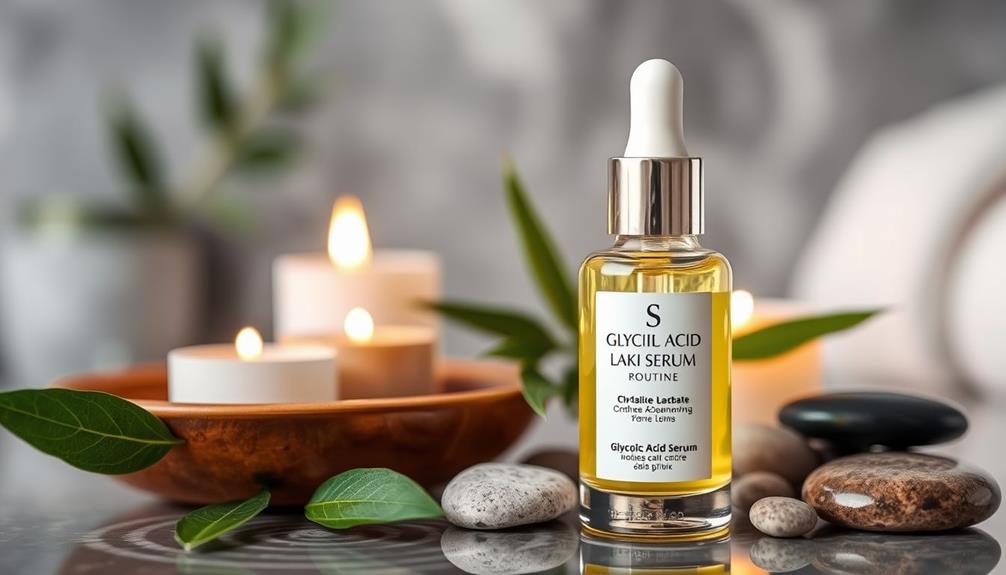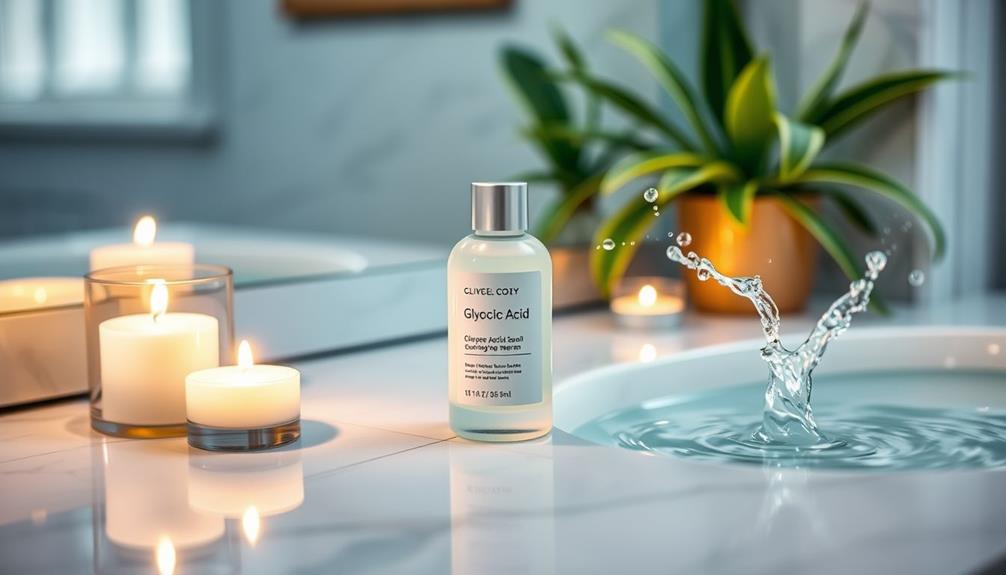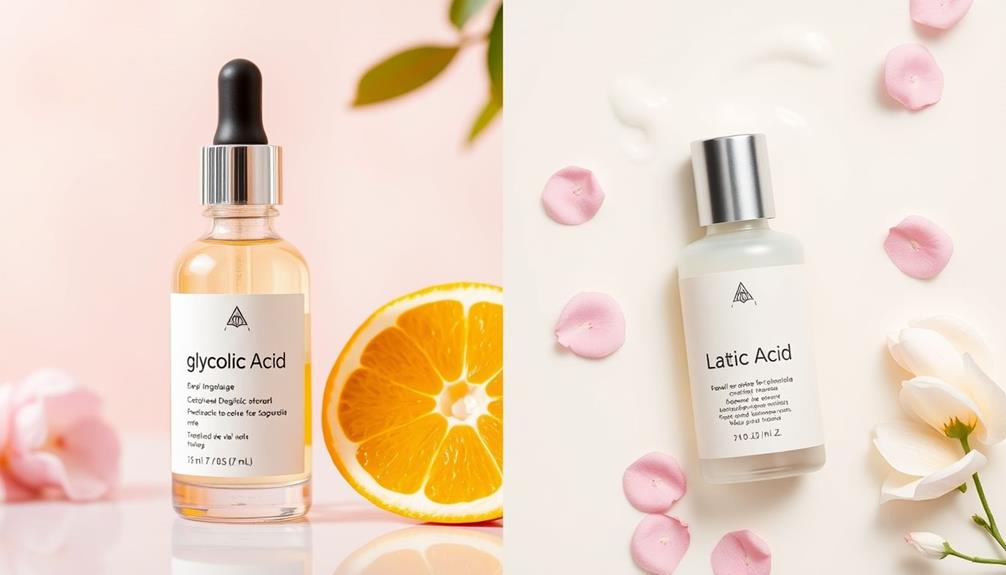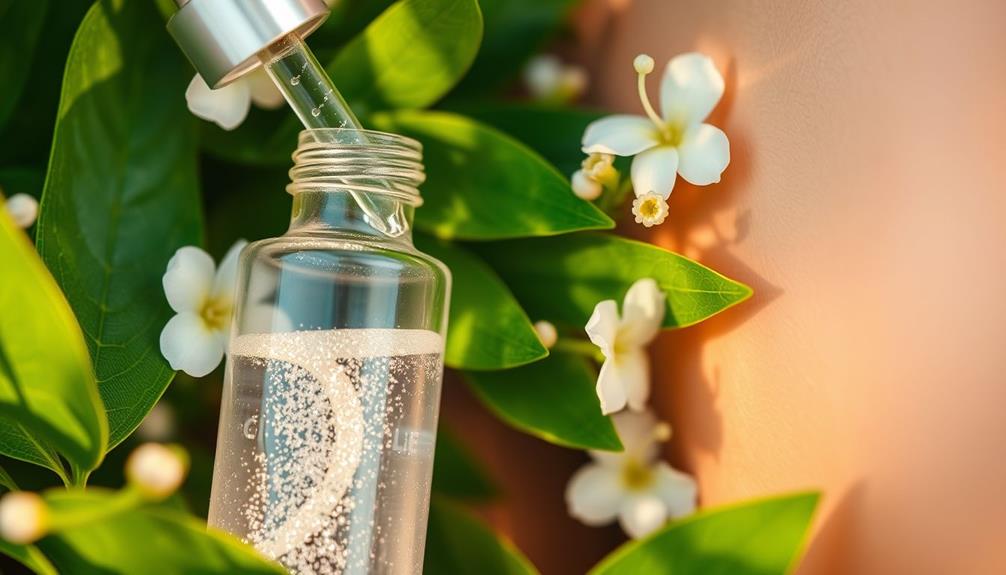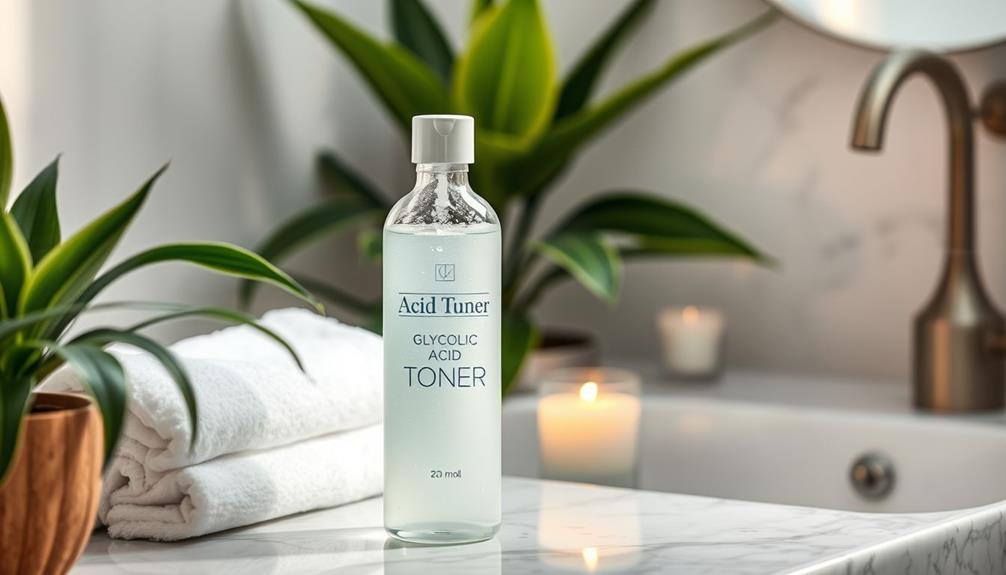Glycolic acid is a game-changer for glowing skin. This powerful ingredient sloughs off dead skin cells, giving you a radiant look. It boosts moisture, stimulates collagen, and diminishes fine lines and dark spots. To harness the full potential of glycolic acid, start slow, apply nightly, and don’t forget your trusty moisturizer and daily sunscreen. Mix and match with other products for maximum impact. Get ready for more insider tips on getting the most out of this skincare gem! See the magic unfold!
Key Takeaways
- Glycolic acid exfoliates the skin by removing dead cells, promoting a smoother, healthier complexion.
- It enhances hydration and stimulates collagen production, contributing to a youthful appearance.
- Regular use reduces hyperpigmentation, fine lines, and wrinkles, serving as an effective anti-aging solution.
- Start with low concentrations and gradually increase frequency to minimize irritation and ensure skin tolerance.
What Is Glycolic Acid?

Glycolic acid is an alpha hydroxy acid (AHA) from sugarcane that effectively exfoliates your skin, helping to remove dead cells and boost renewal. Its small molecular size allows it to penetrate deeply, making it a powerful ingredient in your skincare products. By harnessing its exfoliating properties, you can improve skin texture and achieve a smoother, more radiant complexion. Additionally, incorporating essential oils into your skincare routine can enhance the overall benefits; for example, essential oils for skin can provide nourishing properties that complement glycolic acid's effects.
Incorporating glycolic acid into your routine can greatly enhance your skin's health. As it encourages skin renewal, you'll notice a reduction in dullness and a more vibrant appearance. You can find glycolic acid in various skincare products, including cleansers, toners, and serums, with concentrations typically ranging from 5% to 20%. This versatility makes it easy to integrate into your regimen.
Besides exfoliation, glycolic acid also acts as a humectant, attracting moisture to your skin. This added hydration can further contribute to maintaining healthy skin. By using products containing glycolic acid regularly, you're on your way to achieving the glow and clarity you've always wanted. So, take advantage of this remarkable ingredient and elevate your skincare routine today.
Benefits for Skin Health
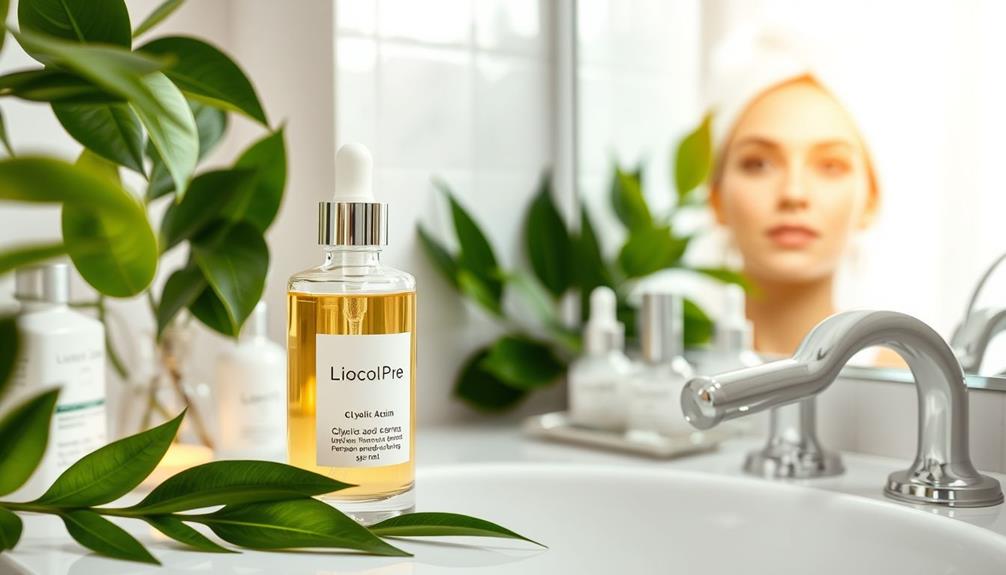
Incorporating glycolic acid into your skincare routine offers numerous benefits for skin health, from enhancing hydration to promoting a more youthful appearance. This powerful alpha hydroxy acid effectively exfoliates by removing dead skin cells, revealing a smoother and more radiant complexion.
You'll notice an immediate improvement in your skin texture and tone, as glycolic acid works to diminish the visibility of sunspots, hyperpigmentation, and uneven skin tone. Additionally, using essential oils, such as Lavender or Frankincense, can complement your skincare routine by providing calming effects and supporting overall skin health through their stress relief properties.
One of the standout benefits of glycolic acid is its ability to stimulate collagen production. This is vital for maintaining your skin's firmness and elasticity, making it an excellent choice for those seeking anti-aging properties. As glycolic acid encourages collagen synthesis, you'll see a reduction in fine lines and wrinkles, giving your skin a more youthful look.
Additionally, glycolic acid serves as a humectant, attracting moisture to your skin and enhancing hydration levels. This means your skin won't only feel plump but also look healthier overall.
Regular use of glycolic acid can transform your skincare routine, addressing multiple concerns while providing an all-around boost to your skin health.
How to Use Glycolic Acid

When you're ready to use glycolic acid, start with a low concentration to gauge your skin's response, especially if you have sensitive skin that may benefit from a holistic lifestyle approach to enhance overall well-being.
Gradually increase the frequency as your skin adjusts, and always apply it at night to reduce sensitivity.
Keep an eye on how your skin reacts, and don't forget to pair it with hydrating ingredients for the best results.
Application Techniques
To achieve the best results with glycolic acid, start by selecting a product with a low concentration, like 5%, to gauge how your skin reacts. This initial step is essential, as different skin types may respond differently to glycolic acid treatments.
It's also important to maintain a consistent skincare routine, as regular application can enhance the effectiveness of the treatment and lead to healthier skin over time. Additionally, understanding your skin's unique needs can help in choosing the right products cat health and nutrition.
Apply the product in the evening on clean, dry skin, using a small amount evenly across your face while avoiding sensitive areas like the eyes and mouth.
To protect your skin barrier, always follow up with a hydrating moisturizing product, as glycolic acid can lead to skin dryness if overused.
It's important to introduce glycolic acid gradually into your skincare routine, starting with once a week. As you become accustomed to the treatment, you can increase the frequency, but be sure to monitor for irritation. If you notice any redness or discomfort, reduce the frequency of application or stick to a lower concentration for a while.
Frequency Guidelines
Determining how often to use glycolic acid is key to maximizing its benefits while minimizing potential irritation.
Start with a low concentration, around 5%, to gauge your skin tolerance. Initially, apply glycolic acid 2-3 times a week at night. This timing not only helps reduce sun sensitivity but also enhances skin renewal while you sleep.
To further support skin health, consider incorporating gentle practices for overall wellness, such as gentle yoga stretches that can help reduce stress and improve skin liveliness.
As your skin adjusts, you can gradually increase the frequency, but avoid using it daily to prevent irritation. Pay close attention to how your skin reacts; if you notice any signs of irritation, like redness or burning, adjust your usage accordingly.
Always follow up with a broad-spectrum sunscreen during the day. Glycolic acid can increase your skin's sensitivity to UV rays, making sun protection essential for maintaining skin health.
Effective Ingredient Combinations
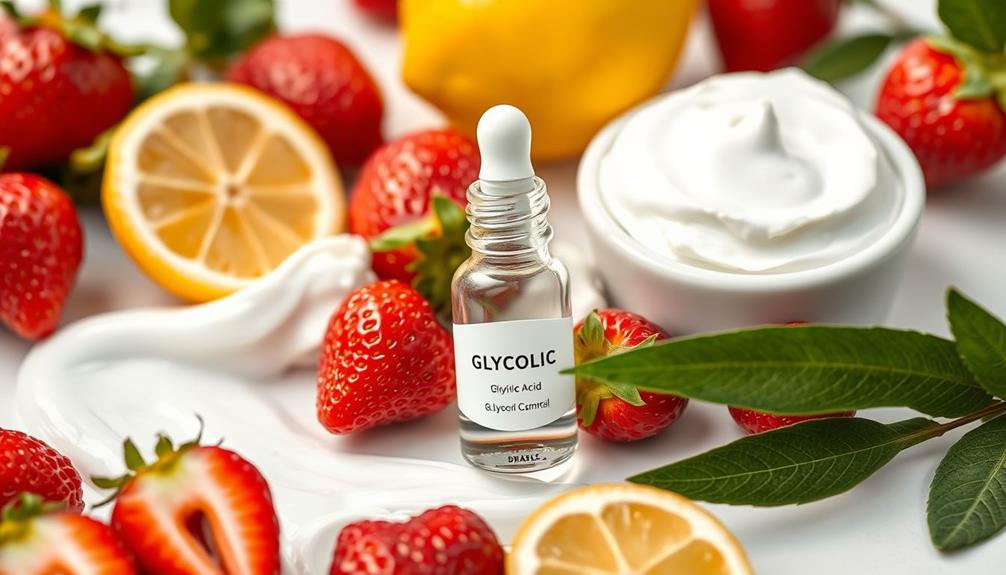
When you're looking to enhance your skincare routine, combining glycolic acid with the right ingredients can make a significant difference.
For instance, pairing it with azelaic acid can effectively target blemishes while boosting absorption.
Additionally, incorporating natural fixes for uneven eyes can further improve your skin's appearance.
Just be cautious with certain combinations to minimize irritation and maintain your skin's health.
Targeting Blemishes Effectively
Combining glycolic acid with other potent ingredients, like azelaic acid and retinol, effectively targets blemishes and uneven skin tone. This powerful duo not only addresses acne but also helps reduce inflammation, promoting overall skin health.
Retinol works wonders alongside glycolic acid by treating both active acne and brown scars, improving your skin's texture over time. To maximize benefits without compromising hydration, consider alternating these ingredients nightly. This method minimizes the risk of excessive dryness while still leveraging their anti-aging and acne-fighting properties.
Just be cautious when layering glycolic acid with other active ingredients. For instance, mixing it with salicylic acid might lead to irritation and dryness, which you want to avoid.
Monitoring your skin reactions is essential. As you introduce glycolic acid and its companions into your routine, pay attention to how your skin responds. This careful observation guarantees you achieve ideal results while maintaining healthy, hydrated skin.
Enhancing Absorption Together
Pairing glycolic acid with other targeted ingredients can greatly enhance absorption, boosting the overall effectiveness of your skincare routine.
For example, combining glycolic acid with azelaic acid not only targets blemishes but also improves absorption, enhancing the treatment's efficacy.
If you're looking to address acne and brown acne scars, using retinol alongside glycolic acid is a powerful strategy. These two ingredients work together to promote skin renewal and clarity.
To maximize their benefits without risking skin damage, consider alternating glycolic acid and retinol on different nights. This method allows you to reap the rewards of both ingredients while minimizing dryness.
However, when it comes to layering glycolic acid with other exfoliating acids like lactic acid, proceed with caution. Too much exfoliation can compromise your skin barrier and lead to irritation.
It's also important to avoid layering glycolic acid with niacinamide, as their differing pH levels can reduce glycolic acid's effectiveness in your skincare routine.
Minimizing Irritation Risks
Minimizing irritation risks is essential for achieving healthy skin while using glycolic acid with other ingredients. By carefully selecting and layering products, you can enhance skin health without causing excessive irritation or dryness. Here's a quick reference for effective ingredient combinations:
| Ingredient | Combination | Notes |
|---|---|---|
| Glycolic Acid | Azelaic Acid | Enhances absorption and targets blemishes. |
| Glycolic Acid | Retinol | Alternate nights to reduce dryness and irritation. |
| Glycolic Acid | Salicylic Acid | Avoid this combo to minimize excessive dryness. |
When layering products, always pay attention to your skin reactions. While azelaic acid and retinol can complement glycolic acid, niacinamide may interfere with its effectiveness due to pH differences. Remember, the goal is to maximize benefits while reducing irritation. Experiment gently and adjust your routine based on how your skin responds to guarantee you maintain a healthy, radiant complexion.
Risks and Precautions

Using glycolic acid can enhance your skincare routine, but it also comes with significant risks and precautions to contemplate.
Many people experience increased skin sensitivity when using glycolic acid, particularly to UV radiation. This makes daily sunscreen use essential to prevent sunburn and long-term damage.
Adverse reactions, such as redness, itching, swelling, and burning, can occur, especially if you have sensitive skin. To minimize the risk of irritation, it's advisable to start with lower concentrations, around 5%, and gradually increase usage. This approach allows your skin to adjust and reduces the chance of overwhelming it.
If you have existing skin conditions, seeking professional guidance before incorporating glycolic acid into your routine is vital. A skincare professional can help assess your skin's needs and recommend the safest way to use this powerful ingredient.
Always monitor your skin reactions closely, as overuse can exacerbate issues, leading to irritation or even hyperpigmentation.
Research and Evidence

Understanding the risks and precautions associated with glycolic acid sets the stage to explore its proven benefits backed by research and evidence.
Numerous studies highlight glycolic acid's effectiveness in promoting skin cell renewal and enhancing texture through chemical exfoliation. In a notable study, glycolic acid peels combined with azelaic acid markedly reduced hyperpigmentation, demonstrating its power in treating conditions like melasma.
Moreover, research indicates that glycolic acid stimulates the production of collagen and hyaluronic acid, which are essential for improving skin elasticity and minimizing the signs of aging. This means you'll not only see a smoother complexion but also experience firmer skin over time.
Additionally, the anti-inflammatory properties of glycolic acid make it an excellent choice for acne treatment. Evidence suggests it's particularly effective against comedonal acne, characterized by clogged pores.
The success of glycolic acid largely hinges on its concentration and pH levels, with lower pH formulations offering greater efficacy and compatibility for your skin.
To conclude, the research underscores glycolic acid as an important ingredient in your skincare routine, delivering multiple benefits for a healthier complexion.
Diagnostic Considerations
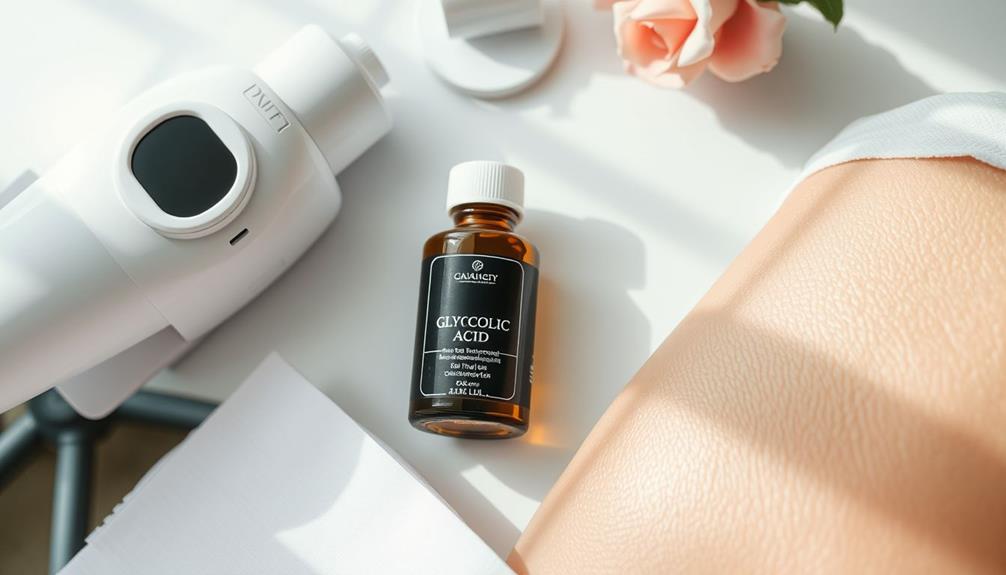
Evaluating your skin type is vital for effectively incorporating glycolic acid into your skincare routine. Understanding whether your skin is oily, dry, or sensitive will guide you in making the right choices. Before you plunge in, conduct patch tests to assess skin sensitivity and check for any adverse reactions to glycolic acid. This step helps you avoid unwanted irritation.
Once you have a grasp of your skin's needs, tailor your active ingredient combinations accordingly. This approach will maximize the benefits of glycolic acid while minimizing any potential irritation. Regularly assess how your skin reacts to new glycolic acid products, adjusting your skincare routines as needed for peak safety and efficacy.
It's important to monitor for signs of over-exfoliation, like redness or peeling. These symptoms indicate that you may need to reduce the frequency or concentration of glycolic acid in your regimen. By staying attuned to your skin's responses, you can guarantee that your use of glycolic acid isn't only beneficial but also safe, leading to healthier, glowing skin over time.
Recommendations for Use

To make the most of glycolic acid in your skincare routine, start with a low concentration and gradually increase as your skin adjusts. This gentle exfoliating agent helps remove dead cells, improving your skin tone and texture. Use it primarily at night to avoid sun sensitivity, applying products just 2-3 times a week to maintain your moisture barrier without over-exfoliating.
Here's a quick reference table for your glycolic acid journey:
| Step | Recommendation |
|---|---|
| Start Concentration | 5% to assess tolerance |
| Application Frequency | 2-3 times a week |
| Best Time to Apply | Night |
| Monitor Reactions | Introduce one product at a time |
| Sunscreen Use | Daily, broad-spectrum |
Keep in mind that combining glycolic acid with sunscreen during the day is essential for protecting your skin from UV damage. By following these recommendations, you'll guarantee that your skincare routine is both effective and safe, paving the way for healthier, glowing skin.
Frequently Asked Questions
What Does Glycolic Acid Do for Your Skin?
Glycolic acid exfoliates your skin, unclogs pores, and promotes a smoother, radiant complexion. It boosts collagen production, reduces fine lines, and helps fade hyperpigmentation, giving you a more youthful and even skin tone.
Is It Good to Use Glycolic Acid Everyday?
Using glycolic acid every day can supercharge your skin's glow! Just start slow to see how your skin reacts. Remember to slather on sunscreen, since it loves to amplify sun sensitivity. Your skin will thank you!
What Not to Pair With Glycolic Acid?
You shouldn't pair glycolic acid with niacinamide, salicylic acid, or lactic acid, as they can cause irritation or reduce effectiveness. Also, avoid combining it with other strong exfoliants to prevent over-exfoliation and sensitivity.
What Food Has the Most Glycolic Acid?
If you're looking for foods high in glycolic acid, sugarcane tops the list, containing about 20-30%. Grapes, pineapples, and beets also provide lower concentrations, but sugarcane's definitely your best bet for this compound.
Conclusion
Incorporating glycolic acid into your skincare routine can transform your skin health, with studies showing it can improve skin texture and tone by up to 30% after just four weeks of consistent use.
This powerful ingredient exfoliates and promotes cell turnover, helping you achieve a radiant complexion.
Remember to start slow and pair it with the right products for maximum benefits.
With the right approach, you'll be on your way to healthier, glowing skin in no time!

